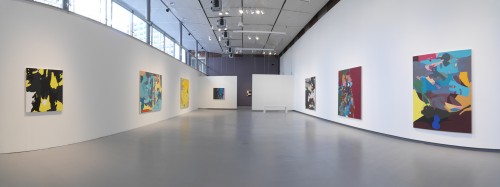
Candida Alvarez. “mambomountain,” panoramic installation view. Courtesy of Hyde Park Art Center. Photo: Tom van Eynde.
I was down at the Hyde Park Art Center this last December. The doors to the main gallery on the first floor were closed when I arrived but I could sense movement behind them; a crack of light beneath the door was regularly interrupted by shadows, making me increasingly curious about the not-yet-open exhibit. Finally someone pulled back the gallery door, flooding the Art Center lobby with light and gushing color. It seemed like the perfect and sudden immersion into Chicago-based Candida Alvarez’s paintings—to have stood on one side of a dim-lit room only to find a world of vibrant color and lush paint waiting behind a door. This is mambomountain—the artist’s most recent collection of large-scale oil and acrylic paintings. The gallery contains several large works in addition to a small studio archive behind two temporary walls—giving visitors permission to connect the inner workings of her process with the resulting, public canvas. mambomountain is on view at the Hyde Park Art Center until March 24, 2013.
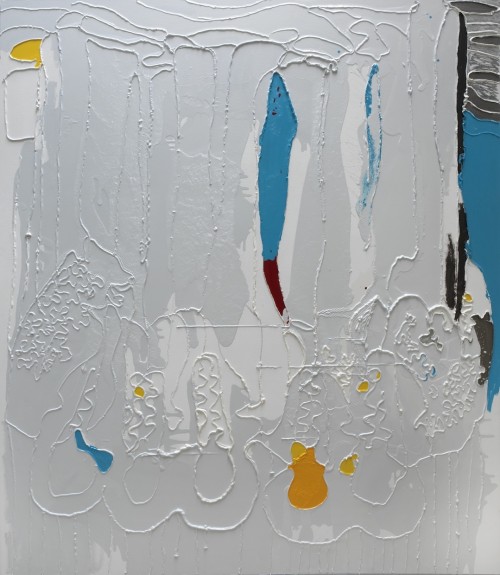
Candida Alvarez. “Chill,” 2011. Oil and acrylic on canvas, 72 x 60 in. Courtesy the artist and Hyde Park Art Center.
Caroline Picard: Can you talk a little bit about how you think about a painting’s relationship to space? Partly, I ask because I read about your show, For Sol Lewitt, where the work seems to intervene marginalized space directly, whether by placing works in an upper corner, or by projection beams of light. (Is that accurate? I only saw photos.) Your show at Hyde Park Art Center is taking similar factors into consideration, even though it might be less apparent as the works are primarily large canvases hung on the wall.
Candida Alvarez: My paintings intervene within a space. They participate and bring into conversation what lies between, above, below, behind, and in front. It is the excitement of taking paintings out of the studio and leading them towards a conversation that can be totally unexpected.
At the Hyde Park Art Center, I created a study room. By adding color and suspending two overlapping portable walls, the dimensions and the mood of the room changed as it heightened a sense of intimacy, which juxtaposed against the larger viewing space, gives those paintings more breathing space.
On the outside wall of the front gallery, there is a monitor that locates me inside my studio space, as you hear me talking about my painting process. I wanted to create an alternative to a wall text in order to possibly grab the attention of the teenagers that roam this community space, who are mostly indifferent to what is on the walls.
Mambo Mountain is an imaginary place, as are these paintings. I grew up in the projects, I rode the elevators up to the 14th floor, and I loved to look out the windows. That is where my mountain started and it has spread to the mountains that my parents grew up on, and live on to this day in Puerto Rico.
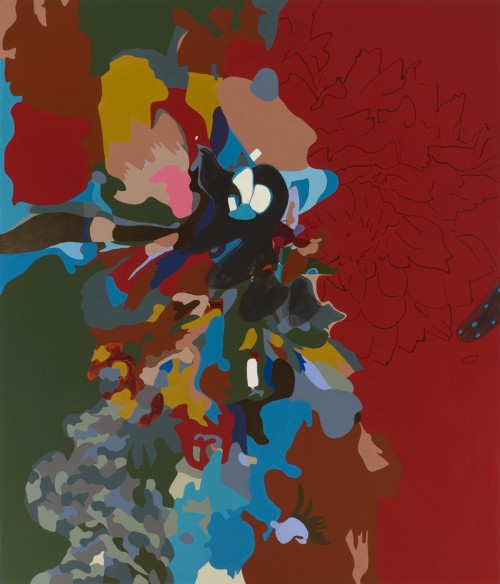
“DaDaDahlia,” 2005-08. Acrylic on canvas. 6ft x 7ft. Courtesy of the artist and Hyde Park Art Center.
CP: How do you think about color, and containing the edges and bounds of certain areas—pinks and browns for instance? There is something so vibrant about your work, it electrifies a whole room, and yet the colors don’t muddy or clash. When I came across a project you had done at PS1 where you made stained glass windows, it occurred to me that your paintings might be composed similarly, with color-borders in mind. Do you compose a picture with borders in mind?
CA: I see in shapes. Colors are the building blocks. I have an archive of pictures, drawings, photographs, postcards, letters, and art history books that I riff from. My working process allows for these shapes to be pulled apart and subverted. The wrestling that ensues becomes the drawing coming face-to-face with the painting. I am seduced by color that lives in the world. I like bright color against dark, rough texture against smooth and shiny against mat. I don’t like to think of my shapes as borders. Stained glass windows were some of my earliest experiences of looking at something two-dimensional. I grew up going to church every Sunday, and it was a catholic church filled with these amazing windows that were tall and thin. I spent most of the hour or so just looking at the color and the lines that held them together. It was years later that I received a commission to create actual windows for a middle school in the South Bronx. I learned how they were made and how important the lead lines are, but in reality they disappear, and it is the power of the sunlight piercing the glass that creates the color—so powerful and so immediate.
CP: How have you internalized or rejected the changing conversation around abstract painting over the years?
CA: I don’t really like the word abstract. It means nothing really, but alludes to some common denominator, which is typically devoid of the body. Well, my work is made up of bodies, which have been mashed up and shredded up into space.
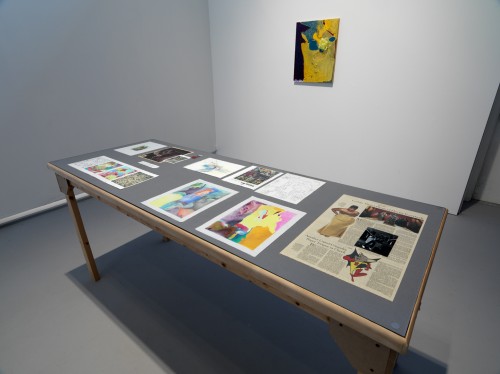
Candida Alvarez. “mambomountain, installation view, studio archive. Courtesy Hyde Park Art Center. Photo: Tom van Eynde.
CP: You recently had a show at Riverside Arts Center, where you made a series of works in vellum. I suppose this ties into the stained glass window question, too, but it made me want to ask why you were drawn to work on vellum, how you think about the transparency/opacity of paint, and then too, the fragility of a work of art, both as a material object and a site of personal…I want to say expression, but that seems like the wrong word somehow. Reflection?
CA: I have been working on vellum for years now. I like its transparency. I started tracing photos of paintings from my mother’s bible to make some of those drawings you saw at the Riverside Art Center. The size is intimate and very portable. I travel with my pads and my pencils wherever I go.
I always begin with something that finds me. Usually, it has lived with me for many years before I pay attention. Sometimes, it is more immediate. My state of making can be somewhat unpredictable. I don’t rely on the personal but on the longing to find companionship in materials. I like discovering relationships through serendipity or through the process of excavation that happens in the studio. All things matter, and at the end of the day, all things become part of that Mambo Mountain. It is a dumping ground, as it is a garden.
Watch Alvarez talk about her work here.
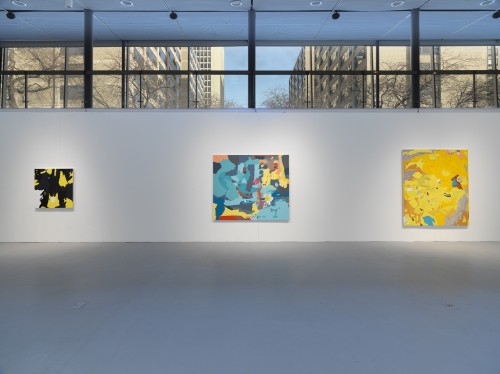
Candida Alvarez, “mambomountain,” installation view. Courtesy of Hyde Park Art Center, photo by Tom van Eynde.



